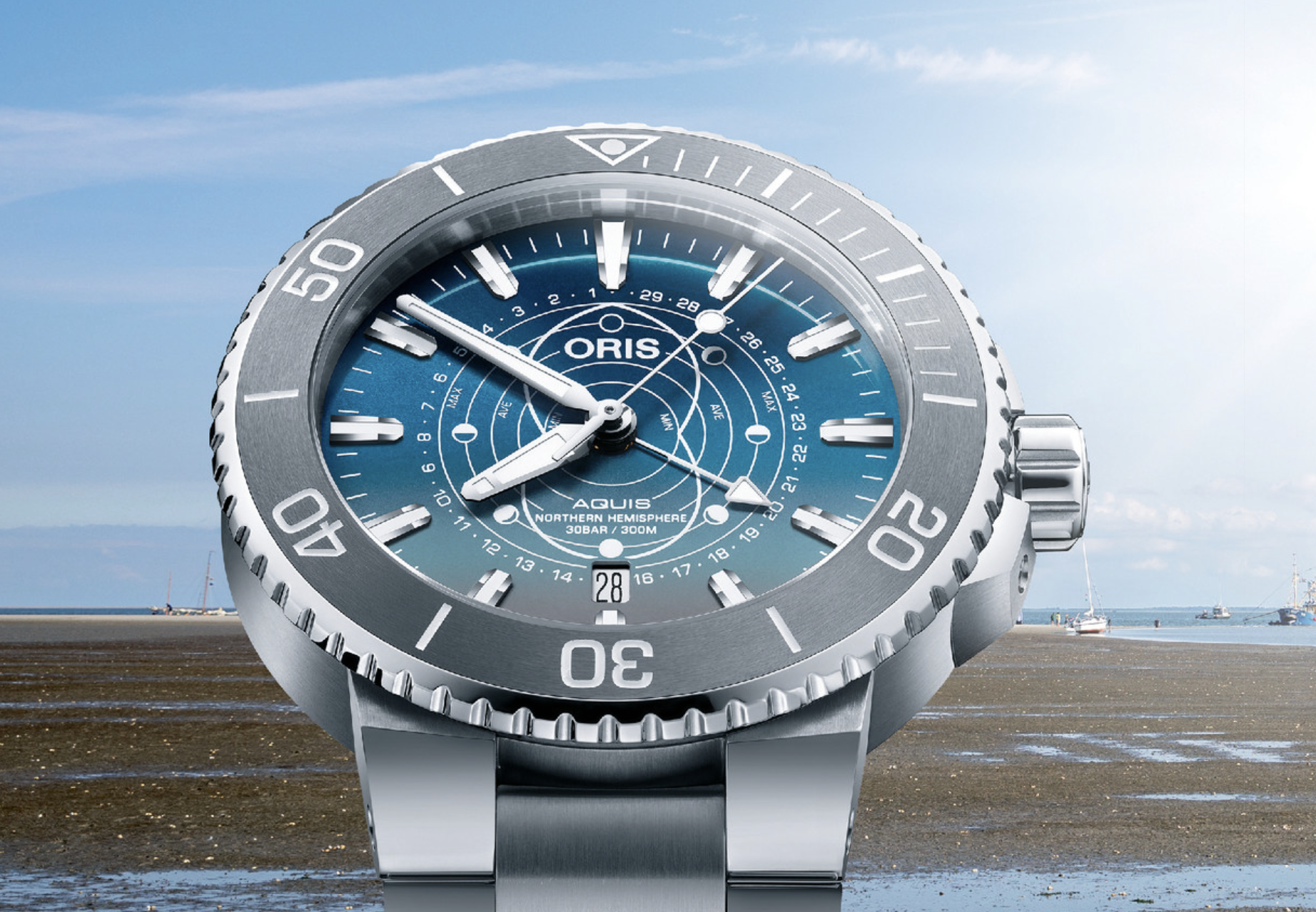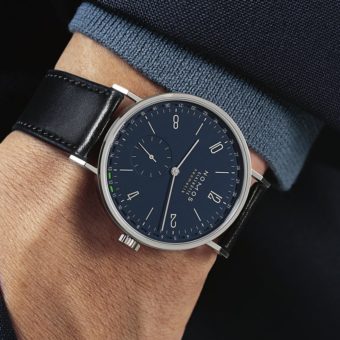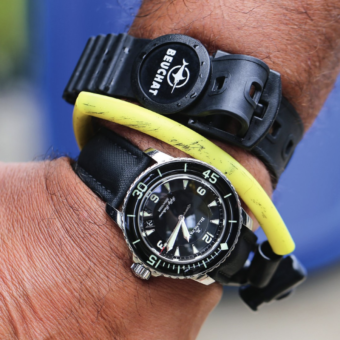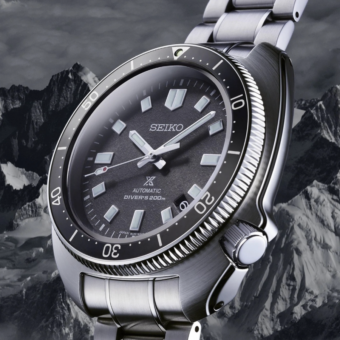This article was originally published in the May/June 2022 Issue of the WatchTime print magazine. Photos by Oris and Olaf Köster.
Oris has been investing in environmental and sustainability projects for more than a decade. In order to draw more attention to its “Change for the Better” initiatives, the company is also launching timepieces like the recently introduced limited-edition Dat Watt dive watch, our test watch. Proceeds from sales of this watch support various charities and the Common Wadden Sea Secretariat, a coordinating body founded in 1987 by the governments of Denmark, Germany and the Netherlands, the three countries that border the Wadden Sea.
Oris and the Common Wadden Sea Secretariat also organize joint events to raise awareness about the special features of this unique natural area. The author was on hand for the first event, which took place in Lauwersoog in the Netherlands. And she wore the Oris Dat Watt dive watch.
Manufactured in a limited edition of 2,009 timepieces, this special model was created in collaboration with the Common Wadden Sea Secretariat and is based on Oris’s Aquis dive watch. The Dat Watt watch takes its name from a local German name for the Wadden Sea, and the number of watches in the series (2,009) refers to the year that the Wadden Sea was granted UNESCO World Heritage status. Just as the mission of the Joint Wadden Sea Secretariat is to preserve this natural area as the world’s largest tidal system, the Dat Watt dive watch aims to track the system’s rhythms.

Anyone who wants to understand this timepiece must be familiar with the tides. This knowledge is essential when you approach the UNESCO World Heritage Wadden Sea, where the tidal change is particularly impressive. Sailors who lack this understanding could quickly be caught with their boats aground on dry land as the tide ebbs, and hikers could miss the retreat on the mudflat as the tide begins to flow in. However, the Dat Watt dive watch does not show high and low tide, but rather the height of the tidal range in the northern hemisphere depending on the lunar cycle, and only here because the Wadden Sea is located in this hemisphere.
The watch’s tidal function was designed in collaboration with experienced professional diver and Oris ambassador Roman Frischknecht, who believes that awareness of the tidal range is crucial for the work of a professional diver.
Oris used the tidal complication for the first time in 2013 in the ProDiver Pointer Moon. With the Dat Watt, the indicator is on a dial that gradually transitions from brown-beige through gray-green to blue, which reflects both the appearance of the Wadden Sea between high and low tide and the chromatic harmony of sky, earth, sand and water. Oris made more than 20 different designs before ending up with this color scheme for the Dat Watt.
The Dat Watt inherited its bold luminous indexes and hands from the Aquis. The fourth, central hand with its white arrowhead is responsible for showing the phase of the moon and its age as well as the associated display of the tidal range. Ebbing and flooding tides are caused by the gravitational pull of the moon and the sun on the Earth, where ebb is the lowest level and flood is the highest level of the water. But ebb and flood also describe the periods in between, when the water is in motion: ebb spans the interval during which the tide flows from its highest to its lowest height while flood represents the period during which the water rises from its lowest to its highest level.

The difference in height between the endpoints of these two phases is called the tidal range. This is not only very different at various locations around the world, but also varies in the course of each lunar cycle. At full and new moon, the sun and the moon are on a line with the Earth, which is why their gravitational effects combine to produce a particularly large tide, the so-called spring tide. On the other hand, when the sun and the moon form a right angle with the Earth at its vertex, this results in a small tide, the neap tide. The dial of the Dat Watt dive watch shows these differences on a calculated curve, which looks like a figure eight or the shape of a peanut. Where the hand with the white arrow pointer intersects the curve, the height of the tidal range can be read. Five circles also make orientation easier. The outer circle marks the water’s highest level, the inner one shows the lowest height, and the middle one indicates the average level. Another circle shows the phases of the moon.
People who live near tidal flats will appreciate the tidal display, but all of this only works properly if the moon’s phase has been set correctly beforehand. This adjustment is made by pulling the crown out to its middle position and then turning it counterclockwise until the hand with the white arrowhead points to the correct position in the lunar cycle, which is shown by eight icons for the waxing and waning moon and 29 numerals for the moon’s age. For this purpose, Oris has added its own moon-phase cadrature to the basic Sellita caliber, an SW200-1. The lunar mechanism works via a conventional moon wheel with 59 teeth, except that this one advances the moon-phase hand not once but twice a day, namely at noon and at midnight, at which time it also switches the date disk. But nature isn’t quite so simple: the interval between two consecutive high tides is about 12 hours and 25 minutes long, so the times of high and low tides shift from one day to the next.
As with the moon-phase display, this results in a deviation of 29.53 days per lunar cycle. However, the 59th tooth on the moon wheel compensates for this slight deviation at the end of every other lunar month. Since each lunar cycle begins at the new moon, it’s best to set the arrowhead pointer at or below 12 o’clock during the afternoon of the day when the moon is new. The hand will then jump forward to its next position at midnight on the first day after the new moon. Of course, the indicator can also be set at any desired time by consulting a lunar calendar and positioning the arrow pointer accordingly.
People who live their lives in harmony with the moon and the tides will love and appreciate this little ritual. As Oris explains, amateur sailors take advantage of the tide to sail in and out of marinas, and professional divers take the tide into consideration when choosing the best time to move underwater objects.

After having devoted so much attention to the tides, it’s also important to remember that the Dat Watt is a professional divers’ watch. This is represented by a stainless-steel case that resists pressure to 30 bar, a robust screw-in back, a knurled and easy-to-use crown that can be screwed open and shut in a sturdy flank, and a bezel that can only be turned counterclockwise. To match the colors on the dial, the bezel is made of gray tungsten rather than the black ceramic that Oris typically uses for its bezels. The Dat Watt’s bezel clicks smoothly but securely into place in half-minute increments and has to-the-minute scaling only for the first 15 minutes. Orientation is provided by the bezel’s luminous dot, which glows in the dark in the same azure blue as the indexes and the hands on the dial. The luminous disk on the slim seconds hand also provides a spectacle with the eight lunar icons, each of which is briefly eclipsed by the disk as it runs its 60-second course around the dial.
The hands are powered by Oris’s automatic Caliber 761, which is based on a Sellita SW200-1. Our timing machine detected slightly unbalanced rate values with maximum gains and losses of 3 seconds per day, but the caliber ran much better on the wrist. The movement is hidden behind the case’s massive screw-in back, which is handsomely decorated with relief engravings of the Wadden Sea and the moon, which causes the everchanging tides.
The case is attached to a sturdy stainless-steel bracelet, which underscores this timepiece’s character as a divers’ watch. An extension piece can be pivoted from inside the onesided pressure-activated folding clasp. Screws secure several of the links near the clasp so the bracelet can be additionally shortened or lengthened. Thanks to this adaptability, this rather generously dimensioned watch even fit well on the wrist of the author as she explored the Dat Watt.
To learn more about Oris, click here, and to subscribe to the WatchTime print magazine, click here.






